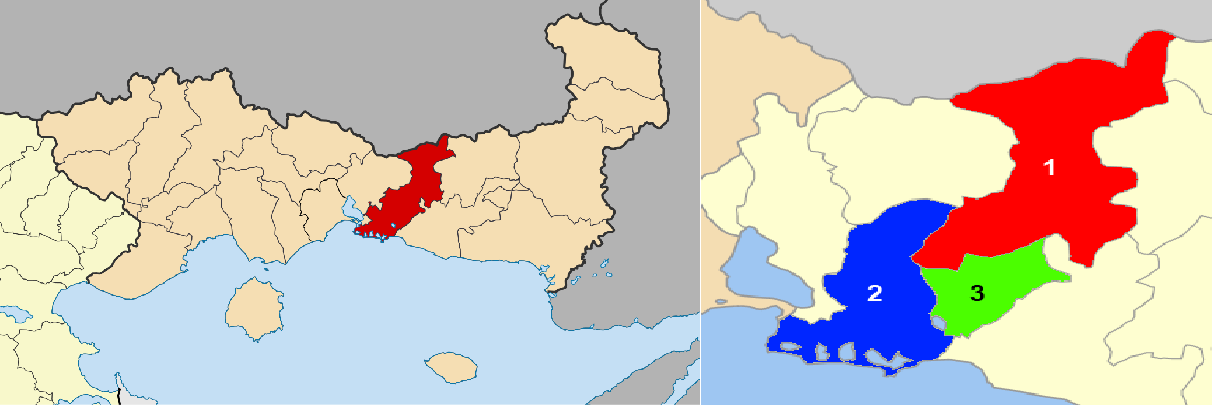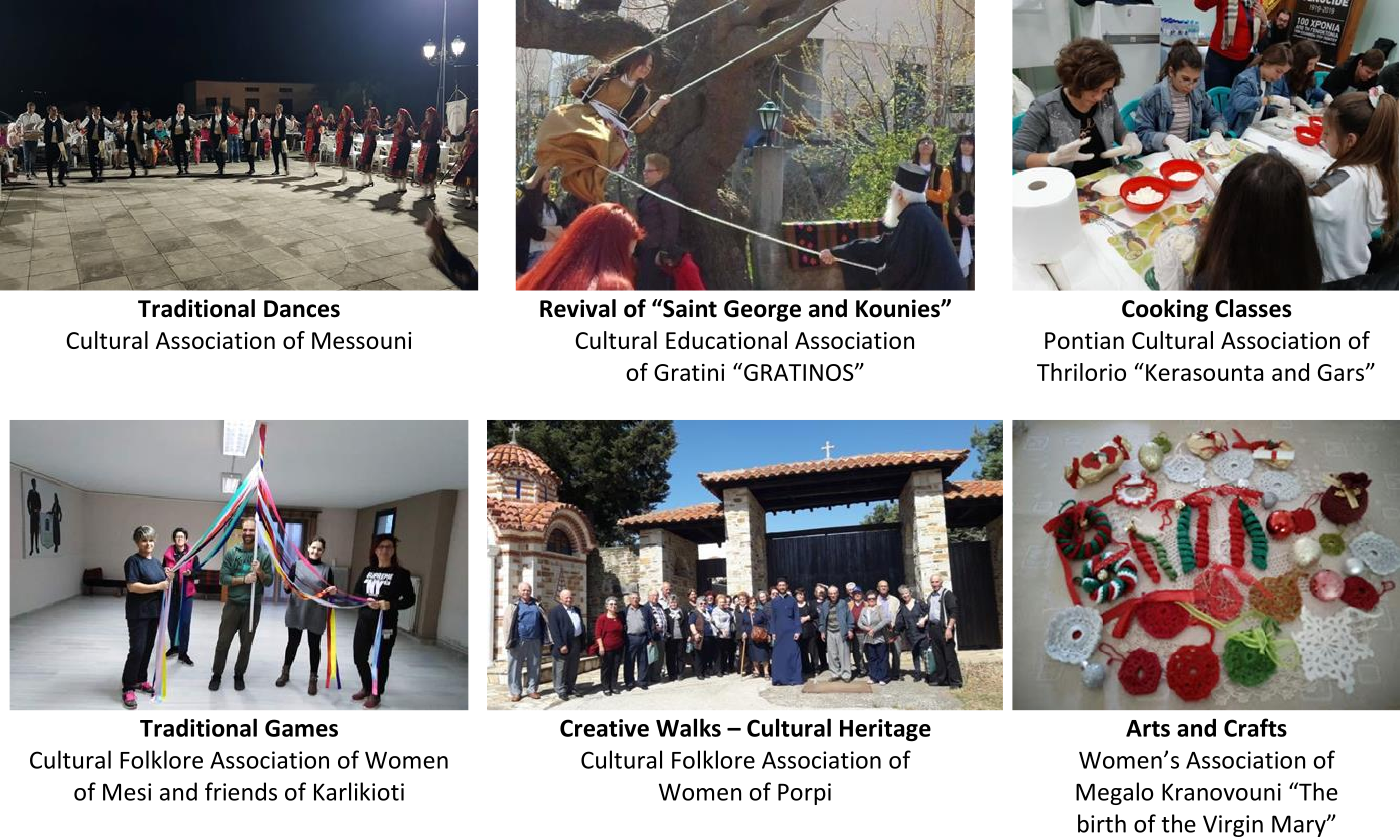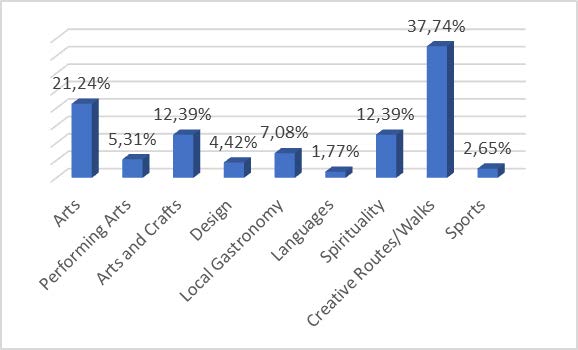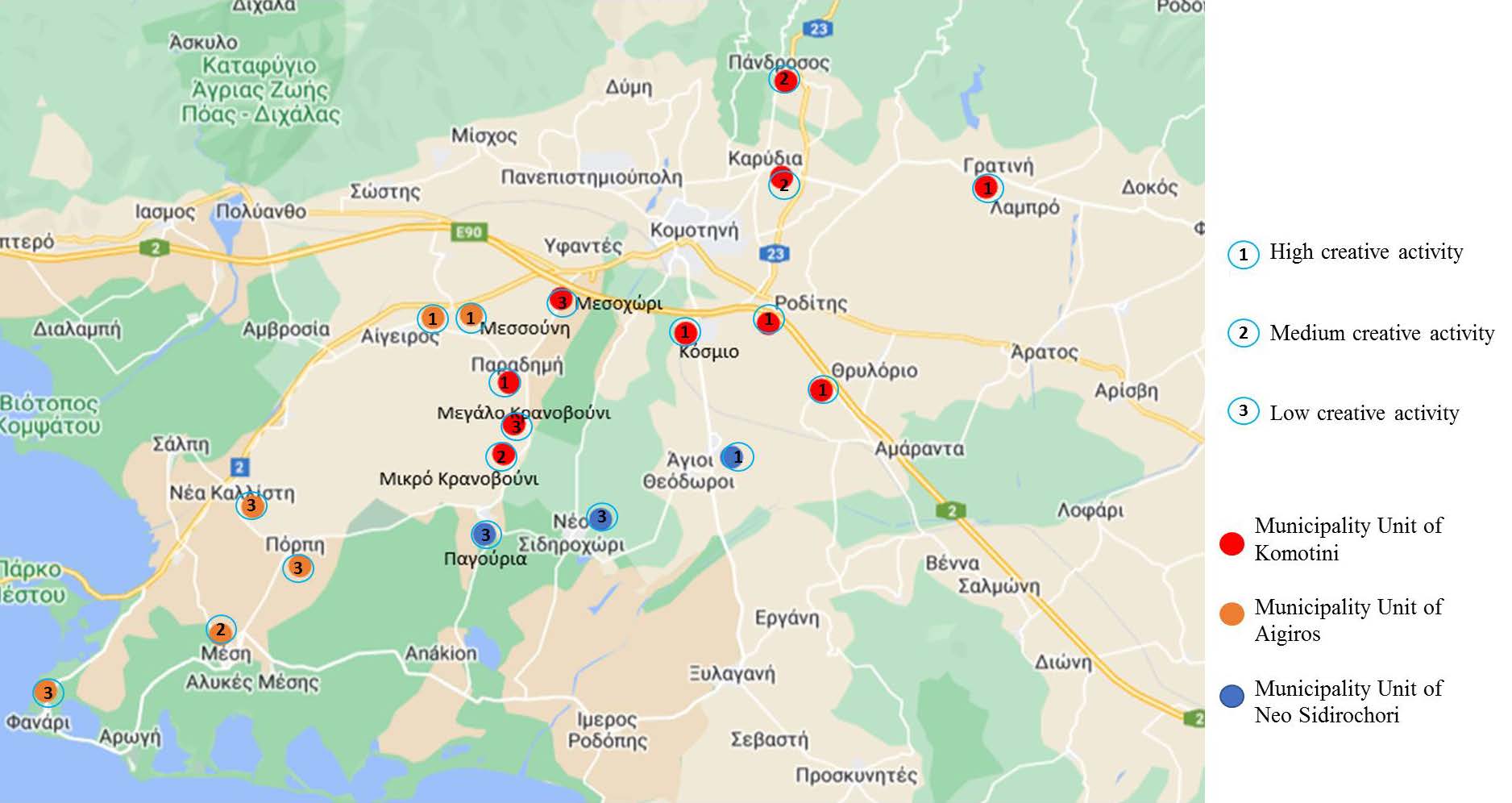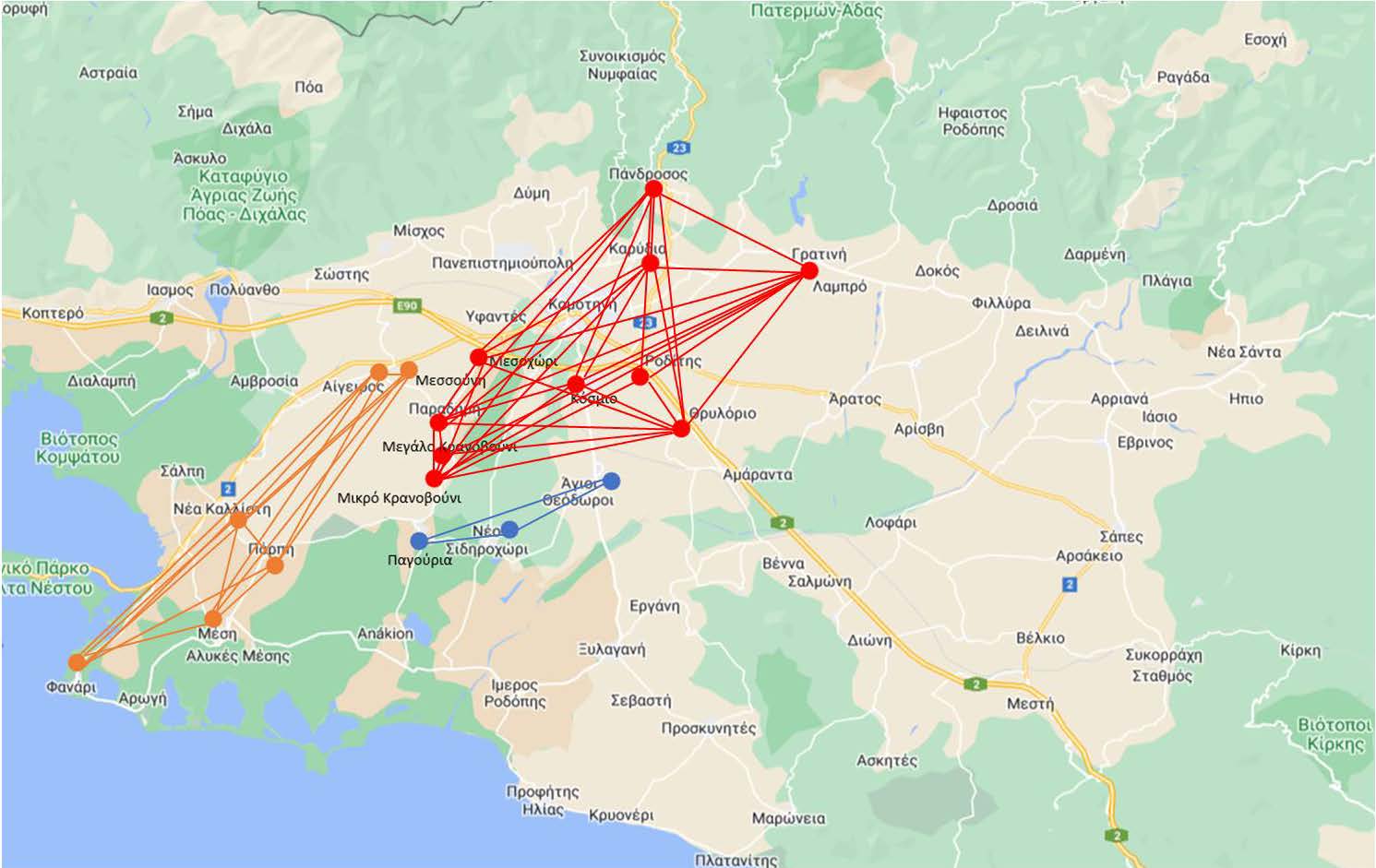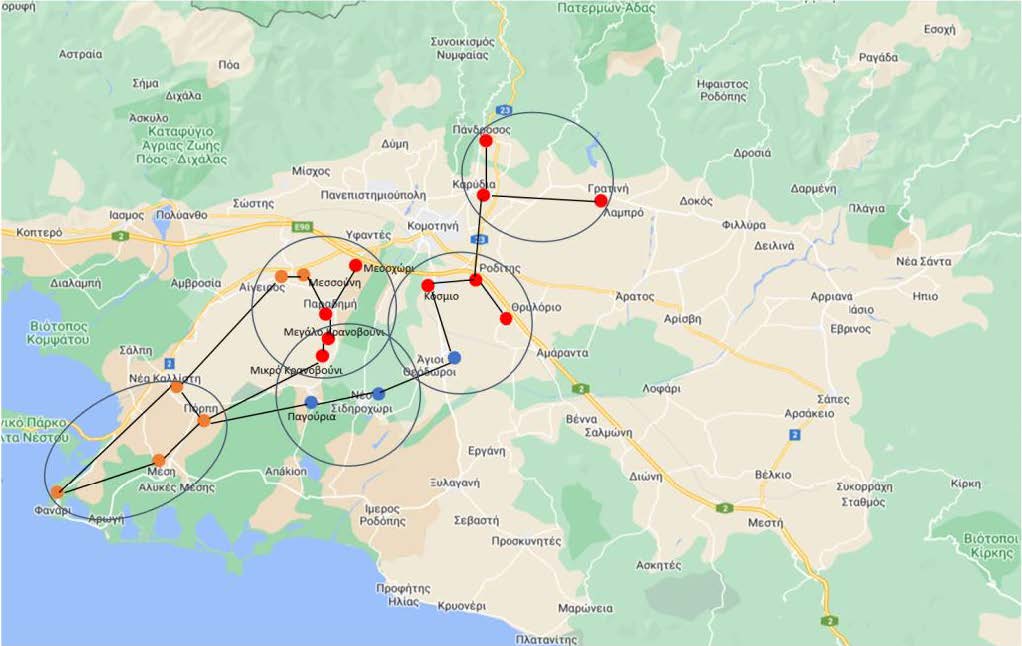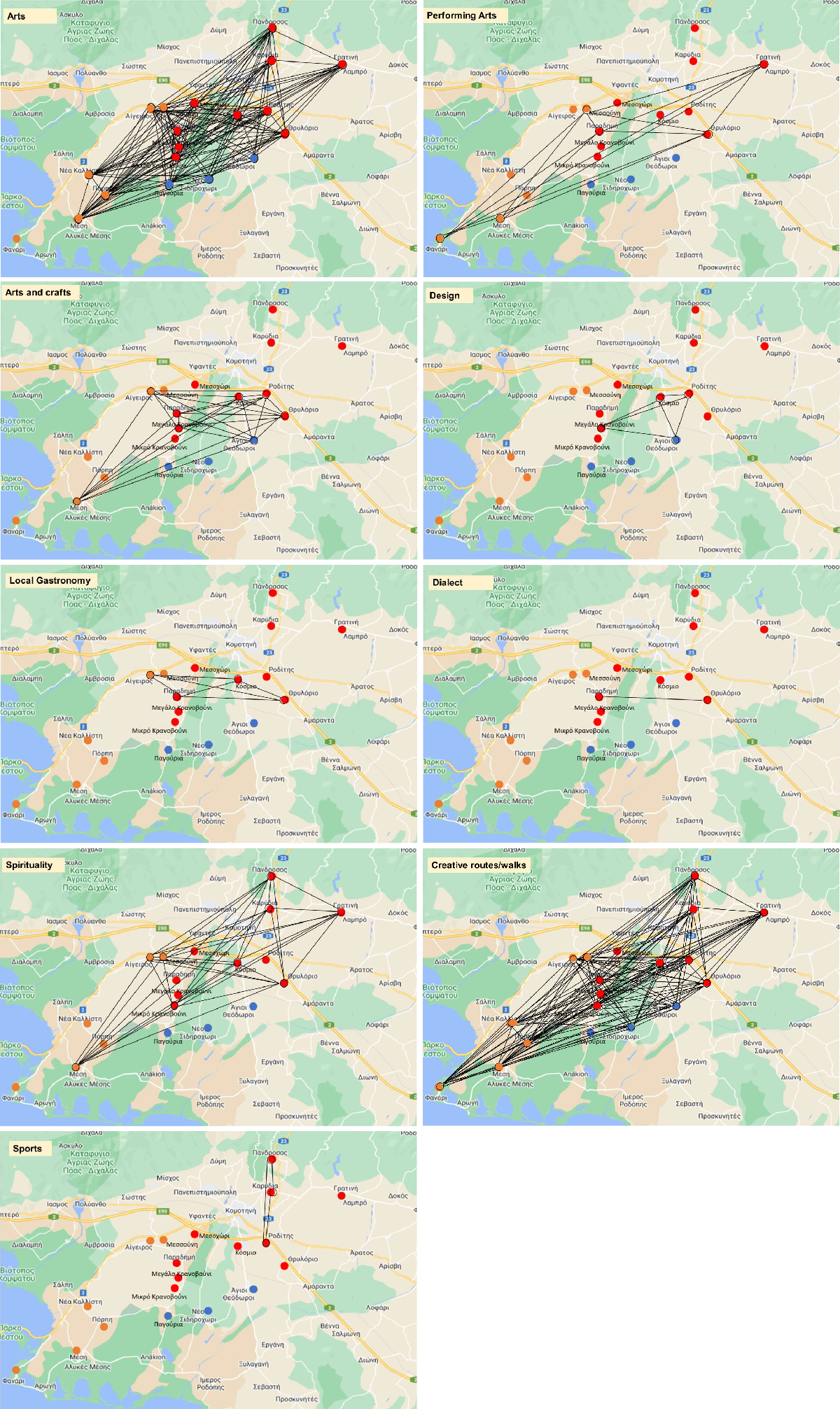Article Peer-Reviewed
Regional Creative Capacity and Creative Tourism Development. The Case of Cultural Associations in Peripheral Areas
Department of Economics, Aristotle University of Thessaloniki, 54124 Thessaloniki, Greece
†
These authors contributed equally to this work.
*
For correspondence.
Academic Editors:
 Snežana Štetić and
Snežana Štetić and  Sara Stanić Jovanović
Sara Stanić Jovanović
Received: 31 May 2023 Accepted: 3 November 2023 Published: 11 November 2023
This article is part of the Special Issue Sustainable Tourism.
Abstract
Creative Capacity (RCC) is a dynamic research topic that integrates authentic creativity, indigenous knowledge, innovation, entrepreneurship, and networking. RCC is a valuable tool for regional policy makers to achieve economic growth, tourism development, and social cohesion in peripheral areas. Cultural Associations, especially in remote areas, serve as “authentic organizations” related to local culture and traditions that support regional uniqueness, identity, and authenticity, and foster creative capacity through various cultural activities (non-typical museums, local cultural events and festivals, revival of customs, rituals, gastronomy, craft etc.). Nowadays, tourists are increasingly seeking “authentic” cultural tourism experiences that require active participation and co-creation in the community’s customs and manifestations. Therefore, cultural associations can be examined within the broader perspective of creative tourism. The purpose of this paper is to investigate whether the dynamics of cultural associations can function as a mechanism to encourage creative tourism in peripheral communities, using four creativity criteria: people, process, product, and environment. The study also aims to examine networking opportunities of cultural associations based on three criteria: administrative, spatial and functional, and to propose novel local creative tourism networks. The qualitative research method employed is a case study approach with structured observation, document analysis, and in-depth interviews with nineteen Cultural Associations in the Regional Unit of Rodopi in Northern Greece. Research findings reveal a strong potential for the development of creative tourism in the broader area with highlighted perspectives and options for further action, while emphasizing the need for networking of cultural associations.
Figures in this Article
Keywords
Copyright © 2023
Malisiova and Kostopoulou. This article is distributed under the terms of the Creative Commons Attribution License (CC BY 4.0), which permits unrestricted use and distribution provided that the original work is properly cited.
Funding
The implementation of the doctoral thesis was co-financed by Greece and the European Union (European Social Fund-ESF) through the Operational Programme «Human Resources Development, Education and Lifelong Learning» in the context of the Act “Enhancing Human Resources Research Potential by undertaking a Doctoral Research” Sub-action 2: IKY Scholarship Programme for PhD candidates in the Greek Universities.
Cite this Article
Malisiova, S., & Kostopoulou, S. (2023). Regional Creative Capacity and Creative Tourism Development. The Case of Cultural Associations in Peripheral Areas. Highlights of Sustainability, 2(4), 241–258. https://doi.org/10.54175/hsustain2040017
References
1.
Pine, J., & Gilmore, J. (1999). The Experience Economy. Harvard Business School Press.
2.
Boekema, F., Morgan, K., Bakkers, S., & Rutten, R. (2000). Introduction to Learning Regions: A New Issue for Analysis. In F. Boekema, K. Morgan, & S. Bakkers (Eds), Knowledge, Innovation and Economic Growth. Edward Elgar Publishing.
3.
Courchene, T. J. (2001). A State of Minds: Towards a Human Capital Future for Canadians. The Institute for Research on Public Policy.
4.
Florida, R. (2002). The Rise of the Creative Class. And How It’s Transforming Work, Leisure and Everyday Life. Basic Books.
5.
Polèse, M., Shearmur, R., Desjardins, P. M., & Johnson, M. (2002). The Periphery in the Knowledge Economy: The Spatial Dynamics of the Canadian Economy and the Future of Non-Metropolitan Regions in Quebec and the Atlantic Provinces. Institut national de la recherche scientifique and the Canadian Institute for Research on Regional Development.
6.
Martin, R. (2007). Making Sense of the New Economy? Realities, myths and geographies. In P. W. Daniels, A. Leyshon, M. J. Bradshaw, & J. Beaverstock (Eds.), Geographies of the New Economy: Critical reflections. Routledge.
7.
Cooke, P., De Leurentis, C., Todtling, F., & Trippl, M. (2007). Regional Knowledge Economies: Markets, Clusters and Innovation. Edward Elgar Publishing.
8.
Hall, H., & Donald, B., (2009). Innovation and Creativity on the Periphery: Challenges and Opportunities in Northern Ontario. Working Paper Series: Ontario in the Creative Age (REF. 2009-WPONT-002). Martin Prosperity Institute.
9.
Licciardi, G., & Amirtahmasebi, R. (2012). The Economics of Uniqueness. Investing in Historic City Cores and Cultural Heritage Assets for Sustainable Development. The World Bank.
10.
Power, D., & Scott, A. (2004). Cultural Industries and the Production of Culture. Routledge.
11.
UNESCO. (2003). Convention for the Safeguarding of the Intangible Cultural Heritage.
12.
Peterson, E. (1996). The Changing Faces of Tradition: A Report on the Folk and Traditional Arts in the United States (NEA Research Division Report 38). The National Endowment for the Arts.
13.
van Dijk, D. (2014). D7.2 Online resources for living heritage. Riches Renewal, Innovation and Change: Heritage and European Society. https://resources.riches-project.eu/wp-content/uploads/2016/05/RICHES-D7-2-Online-resources-for-living-heritage_public.pdf (accessed 20 March 2023).
14.
Staub, S. (2003). Small Organizations in the Folk and Traditional Arts. In Issues in Folk Arts and Traditional Culture Working Paper Series. The Fund for Folk Culture.
15.
Rosenstein, C. (2006). How Cultural Heritage Organizations Serve Communities Priorities, Strengths, and Challenges. The Urban Institute.
16.
Richards, G., & Marques, L. (2012). Exploring creative tourism: Editors Introduction. Journal of Tourism Consumption and Practice, 4(2), 1–11.
17.
Richards, G. (7 November 2020). The role of creativity in challenging times. The 4th Bali International Tourism Conference, Bali, Indonesia.
18.
UNCTAD. (2008). Creative Economy Report 2008. United Nations.
19.
KEA European Affairs. (2009). The Impact of Culture on Creativity. A Study prepared for the European Commission. KEA.
20.
Gong, Z., Nanjappan, V., Lee, L.-H., Soomro, S. A., & Georgiev, G. V. (2023). Exploration of the relationship between culture and experience of creativity at the individual level: a case study based on two design tasks. International Journal of Design Creativity and Innovation, 11, 185–208. https://doi.org/10.1080/21650349.2022.2157889
21.
Glaveanu, V. P., Hanchett Hanson, M., Baer, J., Barbot, B., Clapp, E. P., Corazza, G. E., et al. (2020). Advancing Creativity Theory and Research: A Socio-cultural Manifesto. Journal of Creative Behavior, 54, 741–745. https://doi.org/10.1002/jocb.395
22.
Gülümser, A. A., Baycan-Levent, T., & Nijkamp, P. (2009). Measuring Regional Creative Capacity: A Literature Review for Rural-Specific Approaches. European Planning Studies, 18(4), 545–563. https://doi.org/10.1080/09654311003593614
23.
Collins, P., & Cunningham, J. (2017). Creative Economies in peripheral regions. Palgrave Macmillan Cham. https://doi.org/10.1007/978-3-319-52165-7
24.
Prideaux, B. (2002). Building visitor attractions in peripheral areas—Can uniqueness overcome isolation to produce viability? International Journal of Tourism Research, 4, 379–389. https://doi.org/10.1002/jtr.387
25.
Hooper-Greenhill, E., Dodd, J., Gibson, L., Phillips, M., Jones C., Sullivan, E., et al. (2006). What did you learn at the museum today? Second study: evaluation of the outcome and impact of learning through implementation of Education Programme Delivery Plans across nine Regional Hubs. Research Centre for Museums and Galleries Citation (RCMG).
26.
Travers, T., & Glaister, S. (2004). Valuing Museums: Impact and innovation among national museums. National Museum Directors’ Council.
27.
UNESCO. (2023). Cultural organizations and the promotion of the diversity of cultural expressions. https://www.unesco.org/creativity/sites/default/files/medias/fichiers/2023/06/3-Policy_Perspectives_Spectacles_EN-web2.pdf (accessed 6 November 2023).
28.
Kostopoulou, S., Ballas, D., & Kourkouridis, D. (2012). Spatial Organization of Cultural Industries: The Role of Museums in Regional Creative Capacity (in Greek). The ERSA-GR 10th Regular Scientific Conference, Thessaloniki, Greece.
29.
Del Barrio-Tellado, M. J., Gómez-Vega, M., & Herrero-Prieto, L. C. (2023). Performance of cultural heritage institutions: A regional perspective. Socio-Economic Planning Sciences, 87, 101593. https://doi.org/10.1016/j.seps.2023.101593
30.
OECD. (2018). Culture and local development. Background document. https://www.oecd.org/cfe/leed/venice-2018-conference-culture/documents/Culture-and-Local-Development-Venice.pdf (accessed 15 March 2023).
31.
Bitsani, E. (2004). Cultural Management and Regional Development: Cultural Policy and Cultural Product Design. Dionikos.
32.
Konsola, D. (2006). Cultural Development and Politics. Papazisis.
33.
Rosenstein, C. (2006). How Cultural Heritage Organizations Serve Communities: Priorities, Strengths, and Challenges. Urban Institute. https://www.urban.org/sites/default/files/publication/50646/311376-How-Cultural-Heritage-Organizations-Serve-Communities.PDF (accessed 6 November 2023).
34.
OECD. (2022). Maximising synergies between tourism and cultural and creative sectors. Discussion Paper for the G20 Tourism Working Group. https://t4.oecd.org/cfe/leed/OECD-G20-TWG-Discussion-Paper-Tourism-Cultural-Creative-Sectors.pdf (accessed 1 September 2023).
35.
Carvalho, R., Costa, C., & Ferreira, A. M. (2019). Review of the theoretical underpinnings in the creative tourism research field. Tourism & Management Studies, 15, 11–22. https://doi.org/10.18089/tms.2019.15SI02
36.
Carvalho, R., Costa, C., & Ferreira, A. M. (2023). Creative Tourism Consumption: Framing the Creative Habitus through a Bourdieusian Lens. Sustainability, 15, 1–13. https://doi.org/10.3390/su15032281
37.
Duxbury, N. (Ed.). (2021). Cultural Sustainability, Tourism and Development: (Re)articulations in Tourism Contexts (1st ed.) Routledge. https://doi.org/10.4324/9780367201777
38.
Richards, G., & Raymond, C. (2000). Creative Tourism. ATLAS News, 23, 16–20.
39.
Richards, G. (2005). Textile tourists in the European periphery: New markets for disadvantaged areas? Tourism Review International, 8(4), 323–338. https://doi.org/10.3727/154427205774791519
40.
Richards, G., & Wilson, J. (2006). Developing creativity in tourist experiences: A solution to the serial reproduction of culture? Tourism Management, 27(6), 1408–1413. https://doi.org/10.1016/j.tourman.2005.06.002
41.
Richards, G., & Wilson, J. (2007). Tourism, creativity and development. Routledge.
42.
Wurzburger, R., Aageson, T., Pattakos, A., & Pratt, S. (2010). A Global conversation. How to provide unique creative experiences for travelers worldwide. Sunstone Press.
43.
Richards, G. (2011). Creativity and tourism: The state of the art. Annals of Tourism Research, 38(4), 1225–1253. https://doi.org/10.1016/j.annals.2011.07.008
44.
Baihaqki, U., & Islami, P. Y. N. (2022). Mapping Creative Amenities to Develop Tourism Potentials in a Post-Mining Area: A Case Study of Bantar Karet Village, Bogor Regency, Indonesia. The Indonesian Journal of Geography; Jogjakarta, 54(3), 327–332. https://doi.org/10.22146/ijg.52363
45.
Taylor, C. W. (1988). Various approaches to and definitions of creativity. In R. J. Sternberg (Ed.), The nature of creativity: Contemporary psychological perspectives (pp. 99–121). Cambridge University Press.
46.
Sharpley, R., & Stone, P. R. (2011). Introduction: Thinking about the tourist experience. In R. Sharpley & P. R. Stone (Eds.), Tourism experience; contemporary perspectives. Routledge.
47.
Duxbury, N., Bakas, F. E., Vinagre de Castro, T., & Silva, S. (2021). Creative Tourism Development Models towards Sustainable and Regenerative Tourism, Sustainability, 13(1), 2. https://doi.org/10.3390/su13010002
48.
Ohridska-Olson, R. (2015). Cultural Tourism: Definitions and Typology—A Research Note. https://www.academia.edu/38371940/Cultural_Tourism_Definitions_and_Typology_A_Research_Note (accessed 20 August 2020).
49.
Richards, G., & Duxbury, N. (2021). Trajectories and trends in creative tourism: Where are we headed? In N. Duxbury, S. Albino, & C. P. de Carvalho (Eds.), Creative Tourism: Activating Cultural Resources and Engaging Creative Travellers (pp. 53–58). CABI. https://doi.org/10.1079/9781789243536.0007
50.
Bakas, F. E, Duxbury, N., Silva, S., Vinagre de Castro, T. (2020). Connecting to place through creative tourism. In A. R. Gonçalves, J. F. Marques, M. Tavares, & S. M. Cabeça (Eds.), Creative Tourism Dynamics: Connecting Travellers, Communities, Cultures, and Places. Editora Grácio.
51.
Gato, M. A., Costa, P., Cruz, A. R., & Perestrelo, M. (2022). Creative Tourism as Boosting Tool for Placemaking Strategies in Peripheral Areas: Insights from Portugal. Journal of Hospitality & Tourism Research, 46(8), 1500–1518. https://doi.org/10.1177/1096348020934045
52.
Kühn, M. (2014). Peripheralization: Theoretical Concepts Explaining Socio-Spatial Inequalities. European Planning Studies, 23(2), 367–378. https://doi.org/10.1080/09654313.2013.862518
53.
Bernt, M., & Colini, L. (2013). Exclusion, marginalization and peripheralization. Conceptual concerns in the study of inequalities (Working Paper No. 49). Erkner, Leibniz Institute for Regional Development and Structural Planning.
54.
Reynaud, A. (1981). Société, espace et justice: inéhalités régionales et justice socio-spatiale (in Franch). Presses universitaires de France.
55.
Naustdalslid, J. (1983). Centre-Periphery Models and Theories: Some Introductory Notes. In J. C. Hansen, J. Naustdalslid, & J. Sewel (Eds.), Centre-periphery theory: theory and practice. Regional College.
56.
Keeble, D., Offord, J., & Walker, S. (1988). Core periphery disparities in a community of twelve Member States. CEC.
57.
Spiekermann, K., & Wegener, M. (1996). Trans-European networks and unequal accessibility in Europe. European Journal of Regional Development (EUREG), 4, 35–42.
58.
Copus, A. (1997). A new peripherality index for European regions. H&I European Partnership.
59.
Milne, D. (1997). Placeless power: constitutionalism confronts peripherality. North, 3, 4.
60.
Krugman, P. (1991). Increasing returns and economic geography. Journal of Political Economy, 99, 3.
61.
Krugman, P., & Venables, A. (1995). Globalisation and the inequality of nations. The Quarterly Journal of Economics, 110, 857–880. https://doi.org/10.2307/2946642
62.
Müller, D. K., & Jansson, B. (2007). The difficult business of making pleasure peripheries prosperous: perspectives on space, place and environment. In Tourism in peripheries: perspectives from the far north and south. CABI. https://doi.org/10.1079/9781845931773.0003
63.
Hall, C. M. (2007). North-South perspectives on tourism, regional development and peripheral areas. In D. Müller & B. Jansson (Eds.), Tourism in Peripheries: Perspectives from the Far North and South (pp. 19–37). CABI.
64.
Novotný, L., Mazur, M., & Egedy, T. (2015): Definition and delimitation of peripheries of Visegrad countries. Studia Obszarów Wiejskich, 39, 35–48.
65.
ESPON. (2013). Inner Peripheries: A Socio-Economic Territorial Specificity, Geographic Specificities and Development Potentials in Europe (GEOSPECS). https://www.espon.eu/sites/default/files/attachments/GEOSPECS_Final_Report_inner_peripheries_v14.pdf (accessed 6 November 2023).
66.
UVAL. (2014). A strategy for inner areas in Italy: definition, objectives, tools and governance. The Public Investment Evaluation Unit (UVAL).
67.
Brown, F., & Hall, D. (Eds.). (2000). Tourism in peripheral areas: Case studies. Channel View.
68.
Jones, S. (2005). Community-based ecotourism: The significance of social capital. Annals of Tourism Research, 32(2), 303–324. https://doi.org/10.1016/j.annals.2004.06.007
69.
Komorowski, M., Pepper, S., & Lewis, J. (2021). Joining the Dots -Understanding the value generation of Creative Networks, Cardiff University’s Creative Economy Unit & Creative Cardiff. https://creativecardiff.org.uk/sites/default/files/Joining%20the%20Dots%20research%20report%20-%20understanding%20the%20value%20generation%20of%20creative%20networks.pdf (accessed 8 September 2023).
70.
Castell, M. (2010). The Rise of the Network Society. Wiley-Blackwell.
71.
Felton, E., Collis, C., & Graham, P. (2010) Making Connections: creative industries networks in outer-suburban locations. Australian Geographer, 41(1), 57–70. https://doi.org/10.1080/00049180903535576
72.
Khodabandehloo, A. (2014). Networking for regional development: a case study. EuroMed Journal of Business, 9(2), 149–163. https://doi.org/10.1108/EMJB-10-2013-0045
73.
Lazzeretti, L., Boix, R., & Capone, F. (2009). Why do creative industries cluster? An analysis of the determinants of clustering of creative industries. In IERMB Working Papers in Economics (No. 09.02). Institut d’Estudis Regionals i Metropolitans de Barcelona. http://ddd.uab.cat/pub/worpap/2010/hdl_2072_87967/wpierm0902.pdf (accessed 6 November 2023).
74.
Komorowski, M., & Picone, I. (2020). Creative Cluster Development: Governance, Place-making and Entrepreneurship. Routledge.
75.
Florida, R. (2004). Cities and the Creative Class. Routledge.
76.
Hesmondhalgh, D., & Pratt, A. C. (2005). The cultural industries and cultural policy. The International Journal of Cultural Policy, 11(1), 1–3. https://doi.org/10.1080/10286630500067598
77.
Gibson, C., & Klocker, N. (2004). Academic publishing as ‘creative’industry, and recent discourses of ‘creative economies’: Some critical reflections. Area, 36(4), 423–434.
78.
Kostopoulou, S. (2013). On the Revitalized Waterfront: Creative Milieu for Creative Tourism. Sustainability, 5, 4578–4593. https://doi.org/10.3390/su5114578
79.
Mortati, M., & Cruickshank, L. (2011). Design and SMEs: The trigger of creative ecosystems. In DPPI’11: Proceedings of the 2011 Conference on Designing Pleasurable Products and Interfaces (pp. 1–8). Association for Computing Machinery. https://doi.org/10.1145/2347504.2347550
80.
Kostopoulou, S. (26–28 September 2019). Silk Road Cultural Heritage Tourism Network. The 5th International Conference of International Association for Silk Road Studies IASS SUN “Silk Road: Connecting Cultures, Languages, and Ideas”, Moscow, Russia.
81.
Dijkstra. L., & Poelman, H. (2011). Regional typologies: a compilation. Regional Focus. A series of short papers on regional research and indicators produced by the Directorate-General for Regional Policy (No. 01/2011). European Union.
82.
European Union. (2019). Methodological manual on territorial typologies, 2018 edition. Eurostat. https://doi.org/10.2785/228845
83.
Hellenic Statistical Authority. (2023). Gross Domestic Product Per Capita (NUTS I, NUTS II and NUTS III) / 2020. https://www.statistics.gr/en/statistics/-/publication/SEL57/- (accessed 1 March 2023).
84.
Municipality of Komotini. (2021). Operational program of the Municipality of Komotini 2019-2023.
85.
Crowe, S, Cresswell, K, Robertson, A, Huby, G, Avery, A, & Sheikh, A. (2011). The case study approach. BMC Medical Research Methodology, 11, 100. https://doi.org/10.1186/1471-2288-11-100
86.
Robson, C. (2002). Real World Research: A Resource for Social Scientists and Practitioner-Researchers (2nd ed.). Blackwell Publishers.
87.
Duxbury, N., Silva, S., & Vinagre de Castro, T. (2019). Creative tourism development in small cities and rural areas in Portugal: Insights from start-up activities. In D. A. Jelinčić & Y. Mansfeld (Eds.), Creating and Managing Experiences in Cultural Tourism. World Scientific Publishing.
88.
Rhodes, M. (1961). An analysis of creativity. Phi Delta Kappan, 42, 305–310.
89.
Triarchi, E., & Karamanis, K. (2017). Alternative tourism development: A theoretical background. World Journal of Business and Management, 3, 1. https://doi.org/10.5296/wjbm.v3i1.11198
90.
OECD. (2014). Tourism and the Creative Economy.
91.
UNESCO. (2009). Framework for Cultural Statistics. UNESCO Institute for Statistics.
92.
Gibson, C., Waitt, G., Walmsley, J., & Connell, J. (2010). Cultural Festivals and Economic Development in Nonmetropolitan Australia. Journal of Planning Education and Research, 29(3), 280–293. https://doi.org/10.1177/0739456X09354382
93.
Kostopoulou, S., Sofianou, S., Stergiou, S., & Xanthopoulou-Tsitsoni, V. (2022). Local Culture Festivals and Sustainable Tourism Development in Mountain Areas. The Region of Epirus, Greece, Springer Proceedings in Business and Economics. In V. Katsoni & A. C. Şerban (Eds.), Transcending Borders in Tourism Through Innovation and Cultural Heritage (pp. 497–528). Springer. https://doi.org/10.1007/978-3-030-92491-1_30
94.
Porter, M. E. (1990). The competitive advantage of nations. Macmillan.
95.
Morrison, A., Lynch, P., & Johns, N. (2004). International tourism networks. International Journal of Contemporary Hospitality Management, 16(3), 197–202. https://doi.org/10.1108/IJLPS-05-2013-0012
96.
Halme, M. (2001). Learning for sustainable development in tourism networks. Business Strategy and the Environment, 10(2), 100–114. https://doi.org/10.1002/bse.278
97.
Novelli, M., Schmitz, B., & Spencer, T. (2006). Networks, clusters and innovation in tourism: A UK experience. Tourism Management, 27(6), 1141–1152. https://doi.org/10.1016/j.tourman.2005.11.011
98.
Sørensen, F. (2007). The geographies of social networks and innovation in tourism. Tourism Geographies: An International Journal of Tourism Space, Place and Environment, 9(1), 22–48. https://doi.org/10.1080/14616680601092857
Metrics
Loading...
Journal Menu
Journal Contact
Highlights of Sustainability
Editorial Office
Highlights of Science
Avenida Madrid, 189-195, 3-3
08014 Barcelona, Spain
08014 Barcelona, Spain
Cathy Wang
Managing Editor
